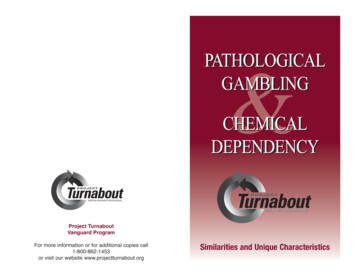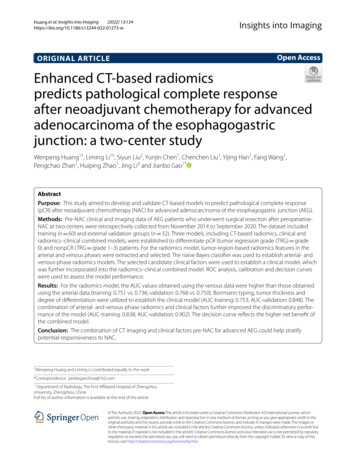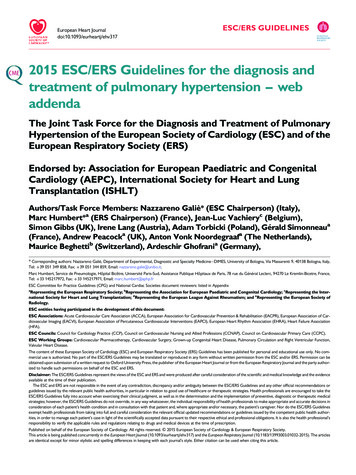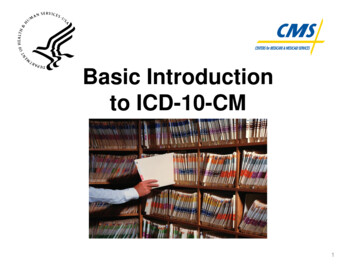
Transcription
(2022) 24:106Zongfei et al. Arthritis Research & pen AccessRESEARCH ARTICLEClinical and pathological predictorsof relapse in IgG4‑related diseaseJi Zongfei1, Chen Lingli2, Sun Ying1, Ma Lingying1, Zhang Lijuan3, Liu Dongmei1, Dai Xiaomin1, Hou Yingyong2,Chen Huiyong1, Ma Lili1,4 and Jiang Lindi1,4*AbstractObjectives: In IgG4-related disease, the relationship between pathological findings and relapse has not been wellestablished. This study aimed to identify the clinical and pathological predictors of disease relapse in IgG4-RD.Methods: Patients with newly diagnosed IgG4-RD (n 71) were enrolled between January 2011 and April 2020; allcases were pathologically confirmed. The clinical and pathological features were recorded in a database at baselineand each follow-up visit. Patients were followed up at least once a month via outpatient clinic examinations andtelephone calls. Univariate and multivariate Cox regression analyses and receiver operating curve (ROC) analysis wereused to identify the predictors of disease relapse and to assess their predictive value.Results: Over a median follow-up of 26 (range, 6–123) months, 3/71 (4.2%) patients died. Of the remaining 68patients, 47 (69.1%) patients had achieved clinical remission and 21 (30.9%) had suffered relapse at the last follow-up.The independent predictors of relapse were IgG4 6.5 g/L (HR 2.84, 95% CI: 1.11–7.23), IgG 20.8 g/L (HR 4.11,95% CI: 1.53–11.06), IgG4-RD responder index (RI) 9 (HR 3.82, 95% CI: 1.28–11.37), and severe I gG4 plasma cellinfiltration (HR 6.32, 95% CI: 1.79–22.41). A prognostic score developed using three of the identified predictors (IgG 20.8 g/L, IgG4-RD RI 9, and severe I gG4 plasma cell infiltration) showed good value for predicting impendingrelapse (AUC , 0.806).Conclusions: In patients with IgG4-RD, IgG4 6.5 g/L, IgG 20.8 g/L, IgG4-RD responder index (RI) 9, and severe IgG4 plasma cell infiltration are predictors of relapse.Keywords: IgG4-related disease, Relapse, Prognostic factorKey messages Among 68 patients with IgG4-RD, 21 (30.9%) suffered relapse during continuous treatment. Independent predictors of relapse were high IgG4,IgG, and IgG4-RD RI and severe I gG4 plasma cellinfiltration.*Correspondence: zsh-rheum@hotmail.com1Department of Rheumatology, Zhongshan Hospital, Fudan University, 180Fenglin Road, Shanghai, ChinaFull list of author information is available at the end of the article A prognostic score developed using three of the identified predictors showed good predictive value.IntroductionIgG4-related disease (IgG4-RD) is a newly recognizedsystemic autoimmune disease that can involve the pancreatobiliary tract, retroperitoneum/aorta, head and neckregion, and salivary glands [1]. The etiology is unknown.Single or multiple organomegaly may be present and,therefore, the disease often has to be differentiated fromtumor [1]. Histopathological examination is one of themajor criteria for the diagnosis of IgG4-RD according to The Author(s) 2022. Open Access This article is licensed under a Creative Commons Attribution 4.0 International License, whichpermits use, sharing, adaptation, distribution and reproduction in any medium or format, as long as you give appropriate credit to theoriginal author(s) and the source, provide a link to the Creative Commons licence, and indicate if changes were made. The images orother third party material in this article are included in the article’s Creative Commons licence, unless indicated otherwise in a credit lineto the material. If material is not included in the article’s Creative Commons licence and your intended use is not permitted by statutoryregulation or exceeds the permitted use, you will need to obtain permission directly from the copyright holder. To view a copy of thislicence, visit http:// creat iveco mmons. org/ licen ses/ by/4. 0/. The Creative Commons Public Domain Dedication waiver (http:// creat iveco mmons. org/ publi cdoma in/ zero/1. 0/) applies to the data made available in this article, unless otherwise stated in a credit line to the data.
Zongfei et al. Arthritis Research & Therapy(2022) 24:106Page 2 of 8the 2019 ACR/EULAR classification criteria, the characteristic findings being I gG4 plasma cell infiltration,storiform fibrosis, and obliterative phlebitis [2, 3].Relapse is common in IgG4-RD, occurring in 24–54%of patients after reduction of glucocorticoid dose [4–9].The 2-year relapse rates are 23.0–41.4% [9, 10]. Patientswith relapse present with reappearance of organomegaly and organ dysfunction (e.g., renal insufficiency, livercirrhosis, intestinal obstruction). Previous studies haveidentified high serum IgG4 level, multiple organ involvement, high IgG4-RD responder index (RI) score, highserum IgE, and high eosinophil count at baseline as predictors of long-term relapse [11, 12]. Increase in memoryB cell count after corticosteroid treatment and persistence of T-follicular helper cells after rituximab are alsoreported to be associated with relapse [13, 14]. In addition, our previous study [8] found serum TNF-α level andIL-2R to be independent predictors of relapse.Although the pathological diagnostic criteria for IgG4RD have been established [15–21], the pathological features associated with disease relapse are not known.The aim of this study was to investigate the relationshipbetween pathological manifestations and disease relapsein IgG4-RD and to identify the independent predictors ofdisease relapse.examination results, pathological findings, imaging data,medical treatments, and disease outcomes were recordedin a database at baseline and each visit.This study was approved by the Ethics Committee inZhongshan Hospital of Fudan University (B2013-115(3))and conformed to the ethical guidelines of the 1975Declaration of Helsinki. Written informed consent wasobtained from all patients.Material and methodsA total of 75 tissue samples were collected from the 71patients and sent to the pathology department of ourhospital. Sections were stained with hematoxylin andeosin (HE), elastic tissue stains, and immunohistochemical stains (including for markers of IgG and IgG4). Theimmunohistochemical antibodies used were rabbit monoclonal anti-IgG4 antibody (EP440, Abcam) and rabbitpolyclonal anti-IgG antibody (A0423, Dako). The numbers of IgG4 and IgG plasma cells were determinedby manually counting the cells in five high-power fields(HPF) with a magnification of 400 under an opticmicroscope and calculating the average; the I gG4 /IgG plasma cell ratio was then calculated [2]. Two pathologists independently evaluated all specimens; a thirdpathologist was consulted if there was any disagreement.PatientsA total of 71 consecutive patients with newly diagnosed IgG4-RD were enrolled for this prospective studybetween January 2011 and April 2020 at the ZhongshanHospital of Fudan University, Shanghai, China. Somepatients visited our department directly while otherswere referred to us from various departments such asgastroenterology, pneumology, otolaryngology, general surgery, and urology. The patients were first classified as probable or definite IgG4-RD using the 2011Japanese Comprehensive Clinical Diagnostic Criteria[15]. Those identified as “probable” IgG4-RD underwentcomprehensive imaging examination for confirmation ofthe diagnosis [22]. The final diagnosis was made by tworheumatologists. All enrolled patients underwent needle biopsy or lesion resection. Patients with concurrentcarcinoma, infection, hematological disease, or otherrheumatic diseases were excluded. Of the 71 patients, 66(93%) satisfied the 2019 ACR/EULAR classification criteria for diagnosis of IgG4-RD [23].Enrolled patients were followed up through outpatient visits and/or telephone calls every month until disease relapse, death, or the end of the study (November2020). All patients completed at least 6 months of follow-up. Demographic data, clinical features, laboratorySerum IgG4 detectionThe immune scatter turbidity method was used to detectthe serum IgG4 level. All tests were performed using aSiemens BN II automatic protein analyzer in our hospitallaboratory, with a limit of 0.08 g/L.Imaging examinationFor the first 3 years, all patients underwent salivary glandultrasound once every 3 months, chest and abdominalcomputed tomography (CT) scan once every 6 months,and/or head, neck, and abdominal magnetic resonanceimaging (MRI) once every 6 months. Additional imagingexaminations were performed if there was suspicion ofreactivation. After the first 3 years, ultrasound was performed once every 6 months and CT once a year.Pathological examinationTreatmentTreatment was started with a glucocorticoid (prednisone), with or without an immunosuppressor agent.The dosage of prednisone was 0.6–0.8 mg/kg/day forthe first 4 weeks; the daily dose was then graduallyreduced by 5 mg every 2 weeks in the first 3 months andby 5 mg every month during the remaining follow-upperiod. The maintenance dose was 0.1–0.2 mg/kg/day.Patients with risk of irreversible organ damage or signsof multiorgan involvement also received single-agent
Zongfei et al. Arthritis Research & Therapy(2022) 24:106Page 3 of 8immunosuppressor therapy with cyclophosphamide (0.6/m2 per month), azathioprine (1–2 mg/kg/day), mycophenolate mofetil (500–750 mg twice a day), or rituximab(100–200 mg/m2/week for 3–4 cycles, followed by onecycle every 6 months).multivariate Cox proportional hazard model (backward,condition). Both the p value and the clinical importancewere concerned when the predictors were incorporatedinto the model [29, 30]. Statistical analysis was performedusing SPSS 22.0 (IBM Corp., Armonk, NY, USA).Disease assessment and definitionsResults1. Disease activity was monitored using the IgG4-RDresponder index (RI) [24], measured at baseline andthen every 3 months during follow-up. The IgG4-RDRI score is based on clinical features and laboratoryand imaging findings [18]. An expert team of tworheumatologists was responsible for the follow-upand disease activity assessment.2. Remission was defined as a decline in IgG4-RD RIscore by 50% and reduction in glucocorticoid dose toless than 0.2 mg/kg/day without relapse throughoutthe follow-up period [7, 25–27].3. Relapse was defined as progressive disease or recurrence of clinical symptoms or imaging findings afterremission, with or without elevation of the serumIgG4 level [7, 25].Clinical and pathological predictorsThe following potential predictors of relapse were investigated: age, sex, medical history, clinical characteristics,laboratory findings, and pathological features.Statistical analysisNormally distributed continuous variables were summarized as means standard deviation and non-normallydistributed variables as medians and interquartile ranges.Categorical variables were summarized as frequenciesand percentages. The independent two-sample Student’st-test, the Mann–Whitney U test, the Kruskal–Wallistest, and the chi-square test were used, as applicable, forcomparison between groups. The optimal cut-off valueswere determined by the receiver operating curve (ROC)analysis, and the area under the curve (AUC) was usedto assess the predictive value of identified factors and thecombined factors. Based on the fact that heavier infiltration was observed in lacrimal and salivary glands andlymph nodes than in visceral organs [2, 28], we estimatedthe optimal cut-off values separately for head and neckorgans and visceral organs. The factors associated withrelapse (binomial variable) were identified using univariate COX regression, Kaplan–Meier curves, and multivariate Cox regression (forward, selection). Two-tailedp 0.05 was considered statistically significant. A predictive score for disease relapse was established using aPatient characteristicsA total of 71 patients (male: female ratio, 3.18:1) wereenrolled. Table 1 shows the characteristics of the patientsand the laboratory test results. The median age at diagnosis was 57 (47–63) years. The median time from onsetof symptoms to diagnosis was 7 (2–22) months. Amongthe 71 patients, 59.2% (42/71) had 2 organ involvement,with median serum IgG4 of 3.90 (1.44–10.19) g/L. Themost frequent clinical manifestations (see SupplementaryTable 1, Additional file 1) were eye-related (20/71, 28.2%),digestive system–related (16/71, 22.5%), and low backpain/lower limb edema/hypertension (14/71, 19.7%).Treatment and follow‑upOver a median follow-up of 26 (range, 6–123) months,3/71 (4.2%) patients died; the causes of death wereinfection (at 2 months), disease progression (intestinalobstruction complicated with septic shock at 5 months),and cerebral infarction (at 8 years). Of the remaining 68patients, 13 (19.1%) received continuous glucocorticoidmonotherapy, and 55 (80.9%) received continuous glucocorticoid plus immunosuppressor therapy. By the endof follow-up, 21/68 (30.9%) patients had relapsed, with amedian time to relapse of 10 (6–30) months; the remaining 47/68 (69.1%) patients had sustained remission during a median follow-up of 17 (7–45.5) months. Therewas no significant difference in the therapy between therelapse patients and the remission patients.Pathological findingsA total of 75 tissue samples were obtained from the 71patients. While 67 patients received biopsy at only onesite, 4 patients received both organ biopsy and lymphnode biopsy. The 75 tissue samples (see SupplementaryTable 2, Additional file 1) came from retroperitoneal tissue (20.0%), lacrimal gland/orbit (17.3%), salivary glands(13.3%), sinuses (8.0%), and so on. The typical pathological findings are shown in Supplementary Fig. 1 and Fig. 2,Additional file 2.Marked lymphocyte and plasmacyte infiltration wasseen in all samples. All samples had 10 IgG4 plasmacells/HPF, with the median count being 50 (30–117) IgG4 plasma cell/HPF. In 73.3% (55/75) of samples, theratio of IgG4/IgG-positive cells was 40%; the medianratio was 40% (33–56%). The IgG4 plasma cell infiltration was significantly more severe in samples from the
Zongfei et al. Arthritis Research & Therapy(2022) 24:106Page 4 of 8Table 1 Baseline characteristics of the patients, stratified by relapse statusAll patients (n 68)Patients in remission(n 47)Patients with relapse(n 21)pAge (years)57 (47–63)57.5 (46.8–64.0)55.5 (41.3–62.8)0.660*Sex (male)51 (75)35 (74)16 (76)0.880**6 (1–20)12 (5–27)0.081*40 (58.8)24 (51.1)16 (76.2)0.045**23 (33.8)13 (27.7)10 (47.6)0.112**Head and neck involvement24 (35.3)17 (36.2)7 (33.3)0.821**Visceral organ involvement46 (67.6)32 (68.1)14 (66.7)0.908**Allergy history14 (23.3)9 (21.95)5 (26.3)0.710**IgG4-RD RI9 (6–12)6 (6–12)9 (6–12)0.038*Serum IgG4 (g/L)3.90 (1.44–10.19)3.09 (1.12–7.26)7.26 (2.68–18.85)0.026*E (%)2.05 (0.50–4.25)2.7 (1.1–4.8)1.5 (0.4–2.2)0.074*ESR (mm/h)41 (12–83)41 (13–82)42 (10–92)0.783*CRP (mg/L)6.1 (0.8–31.5)6.8 (0.73–28.0)4.97 (0.55–50.2)0.955*Serum IgG (g/L)16.7 (11.5–22.9)14.4 (10.9–20.3)19.9 (15.5–34.3)0.011*Serum IgE (IU/mL)112 (24–294)112 (22–260)119 (25–313)0.831*C3 (g/L)0.99 (0.80–1.18)1.02 (0.81–1.21)0.92 (0.72–1.15)0.196*C4 (g/L)0.19 (0.13–0.26)0.23 (0.15–0.27)0.16 (0.07–0.21)0.019*TG (mmol/L)1.12 (0.82–1.83)1.15 (0.94–1.87)0.90 (0.71–1.54)0.046*TC (mmol/L)3.71 (3.38-4.52)4.18 (3.56–4.91)3.38 (2.82–3.72)0.005*LDL (mmol/L)2.20 (1.73-2.64)2.50 (1.98–2.99)1.92 (1.61–2.27)0.030*Time from onset of symptoms to diagno- 7 (2–23)sis (months)Organ involvement 2 3Data are n (%) or median (interquartile range)IgG4-RD RI IgG4-related disease responder index, E eosinophils, PLT platelet count, ESR erythrocyte sedimentation rate, CRP C-reactive protein, TC total cholesterol, TGtriglycerides, LDL low-density lipoprotein*Mann–Whitney U test, **chi-square testhead and neck region (e.g., lacrimal/salivary gland, paranasal sinus, and cervical lymph nodes) than in samplesfrom the viscera (e.g., lung, pancreas, liver and gall bladder, retroperitoneum): 90 (43–200) I gG4 plasma cells/HPF vs. 45 (20–79) IgG4 plasma cells/HPF, respectively(p 0.010). The number of I gG4 plasma cells per highpower field for each organ is shown in SupplementaryTable 2, Additional file 1.Obliterative phlebitis and fibrosis were seen in 30.7%(23/75) and 78.7% (59/75) samples, respectively. Otherpathological manifestations are shown in SupplementaryTable 3, Additional file 1. For patients who had biopsyfrom two sites, only the pathological findings in tissueobtained from the organs were considered.Association between baseline clinical characteristicsand disease relapseTable 1 and Supplementary Table 4, Additional file 1show the general characteristics and laboratory testresults of the 21 patients with relapse and the 47 patientswith sustained remission. Relapse patients had significantly higher prevalence of 2 organ involvement (p 0.045), higher IgG4-RD RI (p 0.038), higher serumIgG4 (p 0.026), and higher serum IgG (p 0.011) atbaseline; moreover, they had significantly lower baselineserum triglyceride (p 0.046), total cholesterol (p 0.005), low-density lipoprotein (p 0.030), and complement 4 (p 0.019) levels.Relationship between pathological manifestationsand disease relapseCompared to patients achieving remission, patients withrelapse had significantly more I gG4 plasma cell infiltration (p 0.013, Table 2), higher prevalence of severe IgG4 plasma cell infiltration—i.e., 60/HPF in visceral organs or 200/HPF in head and neck organs (p 0.002), and lower prevalence of lymphoid follicle formation (p 0.048). However, the prevalence of other pathological characteristics (see Table 2) was similar in relapseand remission patients.Potential risk factors for disease relapseIn univariate Cox regression (Supplementary Table 5,Additional file 1), IgG 20.8 g/L (HR 4.58, 95% CI:
Zongfei et al. Arthritis Research & Therapy(2022) 24:106Page 5 of 8Table 2 Comparison of pathological manifestations between the patients in remission and patients with relapsePatients in remission (n 47)Patients with relapse (n 21)p50 (25–120)70 (40–290)0.013*40.0 (30.0–56.0)40.7 (40.0–59.5)0.644*Severe IgG4 plasma cell infiltration ( 60/HPF in visceral organs or 200/HPF in head and neck organs)21 (44.7%)18 (85.7%)0.002**Fibrosis39 (83.0)18 (85.7)0.777**Storiform fibrosis7 (14.9)2 (9.5)0.546**Obliterative phlebitis16 (34.0)7 (33.3)0.954**Eosinophilic infiltration5 (10.6)1 (4.8)0.430**Lymphoid follicle formation18 (38.3)3 (14.3)0.048**Germinal center formation5 (10.6)1 (4.8)0.430**Number of IgG4 plasma cells/HPF Ratio of IgG4 cell/IgG cell (%) Data are n (%) or median (interquartile range). Statistically significant p values are in bold fontHPF high-power field*Mann–Whitney U test, **chi-square testTable 3 Cox regression multivariate analysis showing factorsindependently associated with IgG4-RD relapseHR95% CIpIgG 20.8 g/LIgG4-RD RI 94.111.53–11.060.005IgG4 6.5 g/L2.841.11–7.230.0293.821.28–11.370.016Severe IgG4 plasma cellinfiltration6.321.79–22.410.004IgG4-RD IgG4-related disease, HR hazard ratio, IgG4-RD-RI IgG4-related diseaseresponder index1.40–15.01), IgG4 6.5 g/L (HR 3.28, 95% CI: 1.12–9.65), IgG4-RD RI 9 (HR 3.75, 95% CI: 1.16–12.09),total cholesterol 3.56 mmol/L (HR 7.50, 95% CI:1.69–33.27), serum triglycerides 0.97 mmol/L (HR 6.11, 95% CI: 1.42–26.36), low-density lipoprotein 2.09mmol/L (HR 5.06, 95% CI: 1.20–21.42), and severe IgG4 plasma cell infiltration (HR 7.43, 95% CI: 1.92–28.68) were all associated with disease relapse. Numberof involved organs 2, C4 0.19 g/L, and lymphoid follicle formation were not associated with relapse.Independent risk factors and a predictive score for diseaserelapseIn multivariate Cox regression (Table 3), the factorsindependently associated with relapse were IgG4 6.5 g/L (HR 2.84, 95% CI: 1.11–7.23), IgG 20.8 g/L(HR 4.11, 95% CI: 1.53–11.06), IgG4-RD RI 9 (HR 3.82, 95% CI: 1.28–11.37), and severe IgG4 plasmacell infiltration (HR 6.32, 95% CI: 1.79–22.41). TheCox proportional hazard model identified three factorsfor incorporation into the predictive model: IgG4-RDRI 9 (p 0.026), severe I gG4 plasma cell infiltration(p 0.007), and IgG 20.8g/L (p 0.056). Though thepredictor IgG was not statistically significant, it was alsoincorporated into the predictive model due to its importance in clinical practice [8, 31]. Upon addition of IgG tothe other two predictors, the optimism corrected AUC(95% CI) of this predictive model increased from 0.736(0.610–0.861) to 0.806 (0.695–0.917).Figure 1A shows the ROCs of the individual predictorsand of the combination of all three. The AUC (95% CI) forIgG, IgG4-RD RI, and severe I gG4 plasma cell infiltration were 0.708 (0.572–0.845), 0.652 (0.514–0.791), and0.712 (0.578–0.847), respectively. Thus, a predictive scorewas created by assigning 1 point for the presence of eachof the three predictive factors; thus, the total score couldrange from 0 to 3. A score of 2 had sensitivity and specificity of 83% and 70%, respectively, for predicting the riskof relapse.Figure 1B shows the cumulative relapse rate inpatients with different predictive scores. The 1-year,2-year, 3-year, and 5-year relapse rates were all significantly different between patients with different prognostic scores (Supplementary Table 6, Additional file 1).The prognostic score showed strong positive correlation with the 1-year, 2-year, 3-year, and 5-year relapserates. The 3-year relapse rate for patients with 0, 1, 2,and 3 points were 0%, 27.3%, 63.6%, and 100%, respectively. The relationship between the three risk factorsand disease relapse at 3 years is further illustrated bythe matrix predictive model in Supplementary Table 7,Additional file 1.DiscussionThe present study aimed to identify the clinical and pathological characteristics that predicted the risk of relapsein patients with IgG4-related disease. The independent
Zongfei et al. Arthritis Research & Therapy(2022) 24:106Page 6 of 8Fig. 1 A ROC curves of the individual predictors and of the combination of predictors of disease relapse. B Cumulative relapse rates (Kaplan–Meiercurve) of patients with different predictive scorespredictive factors of disease relapse included IgG4 6.5g/L, IgG 20.8 g/L, IgG4-RD RI 9, and severe I gG4 plasma cell infiltration. A prognostic score created usingthree of these risk factors (IgG 20.8 g/L, IgG4-RD RI 9, and severe IgG4 plasma cell infiltration) showed goodvalue for predicting the risk of relapse.High IgG4-RD RI score and high IgG4 level have beenfound to be associated with relapse in previous studiesalso [12, 32, 33]. In a cohort of 52 patients with IgG4-RD,Culver et al. found that serum IgG4 2.8 g/L at diagnosis predicted a risk of relapse [32]; however, the authorsdid not describe how the cut-off value was determined.In our study, ROC analysis showed the optimal cut-offvalue of serum IgG4 to be 6.5 g/L. It should be noted,however, that this cut-off is based on data from a singlecenter. Thus, the relationship between serum IgG4 leveland relapse needs further study.Recent studies have investigated whether the 2019ACR/EULAR classification criteria [34] and the novelclinical phenotypes [35] could predict the relapse ofIgG4-RD. However, neither the classification score norhaving a specific clinical phenotype of IgG4-RD seem tobe associated with the risk of relapse. Further research isneeded.Previous studies on IgG4-RD have found that thedegree of infiltration by IgG4-positive plasma cells differsbetween organs [2, 28], with heavier infiltration observedin lymph nodes, lacrimal and salivary glands, and theskin than in the pancreas, lungs, bile ducts, kidneys,aorta, and retroperitoneum [2]. This is consistent withour study, where the number of I gG4 plasma cells perhigh-power field was significantly higher in tissues fromthe head and neck than from the viscera (pancreas, livergall bladder, and retroperitoneal tissues).Marked IgG4 plasma cell infiltration is one of thecharacteristic pathological manifestations of IgG4-RD.The pathogenesis of IgG4-RD remains unknown. Th2cytokines (IL-4, IL-5, and IL-13) production can lead toIgG4 hyperproduction in B cell. IL-21-secreting Tfh cellscould help germinal center formation and promote thedifferentiation from B cell to plasma cell. Several studies have demonstrated that the number of plasmablastsis positively correlated with disease activity and that theappearance of distinct plasmablast clones is associatedwith relapse of IgG4-RD [36, 37]. However, the relationship between the severity of IgG4 plasma cell infiltration and disease activity or relapse is not well established.In this study, severe I gG4 plasma cell infiltrationwas found to be independently associated with diseaserelapse. In clinical practice, based on the findings ofprevious studies, patients with IgG4-RD are consideredto have a low risk of relapse if they have single-organinvolvement, low serum IgG4 level, and low IgG4-RD RI.However, our results suggest that those with a large number of I gG4 plasma cells in the biopsied organ shouldalso be considered to be at risk.The prognostic score that we created using three predictive factors (IgG 20.8 g/L, IgG4-RD RI 9, andsevere IgG4 plasma cell infiltration) shows promisefor predicting the risk of relapse. Therefore, we suggestthat, for patients with a prognostic score of 2 or 3, maintenance treatment including steroid-sparing drugs isrequired. Meanwhile, patients with a score of 1 or 0 onlyneed the initial course of steroids, and long-term treatment can probably be avoided.The IgG4-RD RI score comprises the sum of organsites’ scores plus the serum IgG4 concentration score[24]. Thus, the three risk factors that we selected for our
Zongfei et al. Arthritis Research & Therapy(2022) 24:106scoring system take into consideration almost all theindependent predictive factors identified in our study(i.e., IgG and IgG4 levels, organ involvements, and theseverity of IgG4 plasma cell infiltration). The elevation of total IgG might be due to elevated IgG1 [31] and/or IgG4 levels. Further studies are needed to confirmwhether elevated IgG level has predictive value in allpatients with IgG4-RD.Zhang et al. classified IgG4-RD into two types according to the clinicopathological characteristics: a proliferative type and a fibrotic type [10]. Some features of theproliferative type are consistent with the predictive factors identified in our study, i.e., multiorgan involvement,severe IgG4 plasma cell infiltration, and high serumIgG4 level [38, 39]. The proliferative type is likely to showa better response to therapy, but there is still no definiteclinical evidence. The relationship between clinicopathological types and disease prognosis needs further study.In the present study, different from our previousresearch [8], all patients had pathologically confirmedIgG4-RD. Our focus was on the relationship between thepathological features and relapse; we did not consider theprognostic value of uncommonly evaluated laboratoryparameters (e.g., serum cytokine level).Some limitations of this study must be acknowledged.The sample size was small, and all patients were fromShanghai or its peripheries in east China. However, a sample size of 71 was more than the calculated sample size of63 for this diagnostic test (if sensitivity and specificity wereboth 0.8 0.1). In addition, a selection bias may also existbecause patients who had not received biopsy or resectionwere excluded. Therefore, whether our findings are applicable to all patients with IgG4-RD needs to be clarified infuture research. In this study, we used the 2012 version ofIgG4-RD RI and not the modified IgG4-RD RI published in2018 [40]; this might also have affected our results.ConclusionsIn patients with IgG4-RD, IgG4 6.5 g/L, IgG 20.8g/L, IgG4-RD responder index (RI) 9, and severe I gG4 plasma cell infiltration appear to be independent predictors of relapse. The prognostic score created using threeof the identified predictors (IgG, IgG4-RD RI, and severe IgG4 plasma cell infiltration) could be a useful clinicaltool to identify patients at high risk of relapse.AbbreviationsHPF: High-power field; HR: Hazard ratio; IgG4-RD RI: IgG4-related diseaseresponder index; HB: Hemoglobin; WBC: White blood cell; E: Eosinophils; PLT:Platelet; ESR: Erythrocyte sedimentation rate; CRP: C-reactive protein; ALT:Alanine aminotransferase; AST: Aspartate aminotransferase; Cr: Serum creatinine; TC: Total cholesterol; TG: Triglycerides; LDL: Low-density lipoprotein; ROC:Receiver operating curve; AUC : The area under curve.Page 7 of 8Supplementary InformationThe online version contains supplementary material available at https:// doi. org/ 10. 1186/ s13075- 022- 02792-z.Additional file 1: Supplementary Table 1. Demographic and clinical features of the patients (n 71). Supplementary Table 2. Summary of the75 tissue samples and the number of I gG4 plasma cells per high-powerfield for each organ. Supplementary Table 3. Pathological features in the75 tissue samples. Supplementary Table 4. Baseline patients’ characteristics stratified by relapsed status. Supplementary Table 5. The hazardsratio (HR) and diagnostic efficiencies of factors associated with IgG4-RDrelapse by univariate analysis. Supplementary Table 6. The relapserates in the patients with different prognostic score at 1, 2, 3, and 5 years.Supplementary Table 7. Relationship between the three risk factors andrelapse at 3 years.Additional file 2: Supplementary Figure 1. A. Lymphocyte and plasmacell ( ) infiltration (H&E, 400); B. storiform fibrosis (H&E, 100) ; C. IgG4 plasma cell (immumohistochemical staining, 100); D. eosinophiliainfiltration ( , H&E, 400); E & F. obliterating phlebitis (H&E and elastictissue stain, respectively, 100). Supplementary Figure 2. A-D. Retroperitoneum tissue ( 100): A. (H&E) Marked lymphocyte and plasma cell( ) infiltration and fibrosis ( ); B. (H&E) lymphoid
ate COX regression, Kaplan-Meier curves, and multi-variate Cox regression (forward, selection). Two-tailed p 0.05 was considered statistically signicant. A pre-dictive score for disease relapse was established using a multivariate Cox proportional hazard model (backward, condition). Both the p value and the clinical importance










